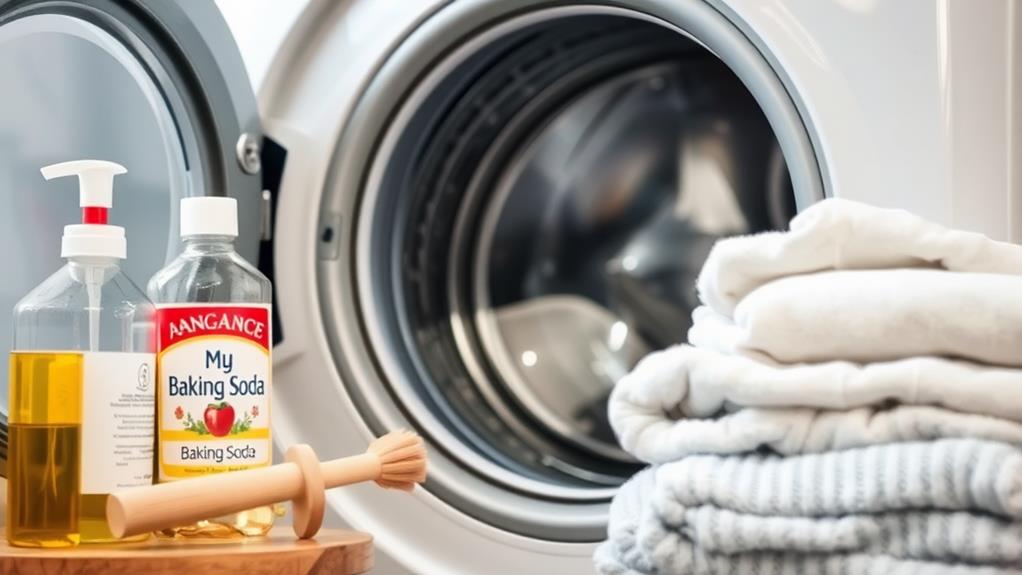How to Deep Clean Your Washing Machine for Fresher Laundry
If you've noticed a musty smell or residue on your clothes after washing, it might be time to deep clean your washing machine. You might think it's enough to toss in another load, but neglecting your machine can lead to buildup that affects your laundry's freshness. By following a few straightforward steps, you can guarantee your appliance works efficiently and keeps your clothes smelling clean. Curious about the best methods to achieve this? Let's explore the process together and uncover tips that can make a significant difference.
Importance of Regular Cleaning

Keeping your washing machine clean is essential for its performance and your laundry's freshness. Regular cleaning helps you avoid unpleasant odors and guarantees your clothes come out smelling great. You wouldn't want to pull out laundry that smells musty, right?
A good deep clean every six months—or more often if you wash a lot—can prevent mold and the buildup of accumulated residue that can affect your machine's efficiency.
By maintaining a clean washing machine, you not only improve overall hygiene but also protect your clothes from dirt and bacteria transfer. If you skip regular maintenance, you might find that your washer has a hard time getting your clothes truly clean.
Those pesky deposits of detergent residue can cling to your clothes, making them feel less fresh.
Common Cleaning Methods
A variety of effective methods exist for cleaning your washing machine, each designed to tackle specific issues like odors and buildup.
One popular technique is using vinegar and baking soda. Just mix half a cup of baking soda in the drum and pour two cups of white vinegar into the detergent compartment. Run a hot water cycle, and voilà! You've got a fresh, clean machine.
If you're dealing with tough stains, consider bleach. Using just half a cup in the detergent compartment during a warm water cycle can kill bacteria and eliminate lingering odors.
Another option is hydrogen peroxide; adding two cups during the hottest cycle helps dissolve dirt without damaging your washer.
You might also want to try commercial cleaners. These specialized washing machine cleaner tabs are designed to break down hard-to-reach grime and mineral deposits.
Simply toss one in the drum and run a hot cycle for a deep clean.
Step-by-Step Cleaning Process

To start the deep cleaning process, make certain your washing machine is empty.
First, pour two cups of white vinegar into the detergent compartment. Then, set your machine to a hot water cycle. This helps dissolve mineral deposits and works wonders for odor elimination.
After the vinegar cycle, sprinkle half a cup of baking soda directly into the drum. Run another hot water cycle to enhance the cleaning power and deodorize your washer.
Don't forget the outside! Wipe down the exterior surfaces and control panel with a damp microfiber cloth to keep everything looking clean.
Now, pay special attention to the rubber gaskets and door seals—they can hide mildew! Use a mix of vinegar and water to scrub these areas, preventing nasty mold from taking over.
Tips for Specific Machines
Different types of washing machines require tailored cleaning techniques to maintain their performance and longevity.
For your front-load washing machines, it's super important to regularly clean the door gasket. Just mix some vinegar and water, and you'll keep mold and mildew at bay, preventing those funky smells.
Top-loading machines are a bit different; you might want to disassemble the agitator once in a while. Soaking it in hot, soapy water or a vinegar solution helps tackle those hard-to-reach spots.
If you have a high-efficiency model, remember not to go overboard with detergent. Too much can leave a messy residue! Using high-efficiency detergent is the way to go.
Always check your owner's manual for tips on cleaning the filter and detergent trays; this helps maintain hygiene and prevents clogs.
After you clean your washing machine, don't forget to leave the door open for a while. This allows air circulation, helping the drum dry out and keeping musty smells away.
Maintenance and Frequency Recommendations

Regular maintenance is key to keeping your washing machine in top shape, and you should aim for a deep clean every 1 to 3 months. This helps prevent grime, mold, and odors from sneaking in, which can leave your laundry less than fresh.
To keep everything running smoothly, make monthly practices a habit. Start by cleaning the detergent dispenser to avoid any gunky build-up. Inspect and clean the filter, and don't forget to wipe down those rubber seals where mold loves to hide.
If you notice musty odors, visible residue on clothes, or even mold peeking out, it's time for a cleaning intervention!
Also, leaving the door open after use promotes air circulation, helping to prevent moisture buildup. If you wash pet items or towels regularly, you might want to deep clean even more often, since those items can be a magnet for unwanted odors and dirt.











Post Comment